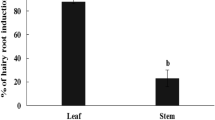Abstract
The transformed root culture of Polygonum tinctorium Lour. was established by infecting leaf explants with Agrobacterium rhizogenes A4. These cultures were examined for their growth and indigo content under various culture conditions. Among the four different culture media tested, SH medium showed the highest yield for root growth (28 mg dry wt/30 ml) and indigo production (152 μg/dry wt). In SH medium, 30 g sucrose l−1, 2500 mg KNO3 l−1, 300 mg NH4H2PO4 l−1 were the best conditions for indigo production at pH 5.7. The production of indigo in hairy roots slightly increased with the addition of 200 mg chitosan l−1 (186 μg/dry wt) and 20 U pectinase l−1 (181 μg/dry wt).
Similar content being viewed by others
References
Chung I, Kim T, Bae G, Lee H, Chae Y (1996) Stimulation of indirubin production by KNO-3 depletion in indole-supplemented suspension culture of Polygonum tinctorium. Biotechnol. Lett. 18: 947–950.
Fox MR, Pierce JH (1990) Indigo: past and present. Textile Chem. Colorist. 22: 13–15.
Hamill JD, Parr AJ, Rhodes MJC, Robins RJ, Walton NJ (1987) New routes to plant secondary products. Biotechnology 5: 800–804.
Kim SU, Song KS, Jung DS, Chae YA, Lee HJ (1996) Production of indoxyl derivatives in indole-supplemented tissue cultures of Polygonum tinctorium. Planta Medica 62: 54–56.
Kohda H, Niwa A, Nakamoto Y, Takeda O (1990) Flavonoid glucosides from Polygonum tinctorium. Chem. Pharm. Bull. 38: 523–524.
Murashige T, Skoog F (1962) A revised medium for rapid growth and bioassays with tobacco tissue cultures. Physiol. Plant. 15: 473–497.
Parr AJ, Hamill JD (1987) Relationship between Agrobacterium rhizogenes transformed hairy roots and intact uninfected Nicotiana plants. Phytochemistry 26: 3241–3245.
Petit A, David C, Dahl GA, Ellis JG, Guyon P, Casse-Delbart F, Tempe J (1983) Further extension of the opine concept: plasmids in Agrobacterium rhizogenes cooperate for opine degradation. Mol. Gen. Genet. 190: 204–214.
Sauerwein M, Yamazaki T, Shimomura K (1991) Hernandulcin in hairy root cultures of Lippia dulcis. Plant Cell Rep. 9: 579–581.
Schenk RU, Hildebrandt AC (1972) Medium and techniques for induction and growth of monocotyledonous and dicotyledonous plant cell cultures. Can. J. Bot. 50: 199–204.
Xia ZQ, Zenk MH (1992) Biosynthesis of indigo precursors in higher plants. Phytochemistry 31: 2695–2697.
Author information
Authors and Affiliations
Rights and permissions
About this article
Cite this article
Young-Am, C., Yu, HS., Song, JS. et al. Indigo production in hairy root cultures of Polygonum tinctorium Lour.. Biotechnology Letters 22, 1527–1530 (2000). https://doi.org/10.1023/A:1005668625822
Issue Date:
DOI: https://doi.org/10.1023/A:1005668625822




